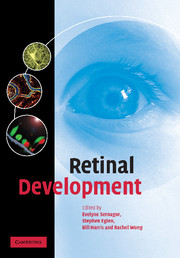Book contents
- Frontmatter
- Contents
- List of contributors
- Foreword
- Preface
- Acknowledgements
- 1 Introduction – from eye field to eyesight
- 2 Formation of the eye field
- 3 Retinal neurogenesis
- 4 Cell migration
- 5 Cell determination
- 6 Neurotransmitters and neurotrophins
- 7 Comparison of development of the primate fovea centralis with peripheral retina
- 8 Optic nerve formation
- 9 Glial cells in the developing retina
- 10 Retinal mosaics
- 11 Programmed cell death
- 12 Dendritic growth
- 13 Synaptogenesis and early neural activity
- 14 Emergence of light responses
- New perspectives
- Index
- Plate section
- References
11 - Programmed cell death
Published online by Cambridge University Press: 22 August 2009
- Frontmatter
- Contents
- List of contributors
- Foreword
- Preface
- Acknowledgements
- 1 Introduction – from eye field to eyesight
- 2 Formation of the eye field
- 3 Retinal neurogenesis
- 4 Cell migration
- 5 Cell determination
- 6 Neurotransmitters and neurotrophins
- 7 Comparison of development of the primate fovea centralis with peripheral retina
- 8 Optic nerve formation
- 9 Glial cells in the developing retina
- 10 Retinal mosaics
- 11 Programmed cell death
- 12 Dendritic growth
- 13 Synaptogenesis and early neural activity
- 14 Emergence of light responses
- New perspectives
- Index
- Plate section
- References
Summary
Introduction
Interest in programmed cell death (PCD) emerged over a century ago (reviewed in Clarke and Clarke, 1996), and such naturally occurring cell death in the developing nervous system has been extensively documented (Oppenheim, 1991 for review). More recently, the concept of PCD has been the subject of some controversy mainly due to the overwhelming interest in one of its forms, apoptosis (Sloviter, 2002). For the purpose of this chapter, PCD is defined simply as a sequence of events based on cellular metabolism that leads to cell destruction (Lockshin and Zakeri, 2001; Guimarães and Linden, 2004), without commitment to particular morphological types.
Programmed cell death has been identified using a variety of techniques, though each of them is prone to errors when estimating the magnitude of cell loss. Estimating the size of the population based on counts of axons in developing nerves or tracts may be confounded by the simultaneous occurrence of both cell death and axonal ingrowth, and by the transient contaminating presence of other axonal populations. Estimates based on cell counts may be influenced by the continuous migration of differentiating cells into spatially delimited cell populations, as well as by the inclusion of other types of cells that are not so readily discriminable at earlier developmental stages. And while great progress has been made in understanding the molecular mechanisms of apoptosis in the last decade, multiple alternative pathways of PCD add a further degree of complexity in understanding developmental cell death and estimating its magnitude.
- Type
- Chapter
- Information
- Retinal Development , pp. 208 - 241Publisher: Cambridge University PressPrint publication year: 2006
References
- 3
- Cited by

